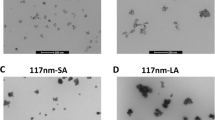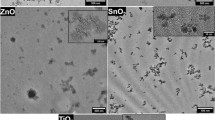Abstract
Nanoparticles (NP) have a tendency to agglomerate after dispersion in physiological media, which can be prevented by the addition of serum. This may however result in modification of the toxic potential of particles due to the formation of protein corona. Our study aimed to analyze the role of serum that is added to improve the dispersion of 10 nm TiO2 NPs on in vitro and in vivo effects following the exposure via the respiratory route. We characterized NP size, surface charge, sedimentation rate, the presence of protein corona and the oxidant-generating capacity after NP dispersion in the presence/absence of serum. The effect of serum on NP internalization, cytotoxicity and pro-inflammatory responses was assessed in a human pulmonary cell line, NCI-H292. Serum in the dispersion medium led to a slower sedimentation, but an enhanced cellular uptake of TiO2 NPs. Despite this greater uptake, the pro-inflammatory response in NCI-H292 cells was lower after serum supplementation (used either as a dispersant or as a cell culture additive), which may be due to a reduced intrinsic oxidative potential of TiO2 NPs. Interestingly, serum could be added 2 h after the NP treatment without affecting the pro-inflammatory response. We also determined the acute pulmonary and hepatic toxicity in vivo 24 h after intratracheal instillation of TiO2 NPs in C57BL/6N mice. The use of serum resulted in an underestimation of the local acute inflammatory response in the lung, while a systemic response on glutathione reduction remained unaffected. In conclusion, serum as a dispersion agent for TiO2 NPs can lead to an underestimation of the acute pro-inflammatory response in vitro and in vivo. To avoid potential unwanted effects of dispersants and medium components, we recommend that the protocol of NM preparation should be thoroughly tested, and reflect as close as possible realistic exposure conditions.



Similar content being viewed by others
References
Bihari P, Vippola M, Schultes S, Praetner M, Khandoga AG, Reichel CA, Coester C, Tuomi T, Rehberg M, Krombach F (2008) Optimized dispersion of nanoparticles for biological in vitro and in vivo studies. Part Fibre Toxicol 5:14
Brown DM, Dickson C, Duncan P, Al-Attili F, Stone V (2010) Interaction between nanoparticles and cytokine proteins: impact on protein and particle functionality. Nanotechnology 21(21):215104
Casals E, Pfaller T, Duschl A, Oostingh GJ, Puntes V (2010) Time evolution of the nanoparticle protein corona. ACS Nano 4(7):3623–3632
Chithrani BD, Ghazani AA, Chan WC (2006) Determining the size and shape dependence of gold nanoparticle uptake into mammalian cells. Nano Lett 6(4):662–668
Cohen JM, Teeguarden JG, Demokritou P (2014) An integrated approach for the in vitro dosimetry of engineered nanomaterials. Part Fibre Toxicol 11:20
Colvin VL (2003) The potential environmental impact of engineered nanomaterials. Nat Biotechnol 21(10):1166–1170
Dhawan A, Sharma V, Parmar D (2008) Nanomaterials: a challenge for toxicologists. Nanotoxicology 3(1):1–9
Donaldson K, Borm PJ, Oberdorster G, Pinkerton KE, Stone V, Tran CL (2008) Concordance between in vitro and in vivo dosimetry in the proinflammatory effects of low-toxicity, low-solubility particles: the key role of the proximal alveolar region. Inhal Toxicol 20(1):53–62
Fenoglio I, Fubini B, Ghibaudi EM, Turci F (2011) Multiple aspects of the interaction of biomacromolecules with inorganic surfaces. Adv Drug Deliv Rev 63(13):1186–1209
Geraets L, Oomen AG, Krystek P, Jacobsen NR, Wallin H, Laurentie M, Verharen HW, Brandon EF, de Jong WH (2014) Tissue distribution and elimination after oral and intravenous administration of different titanium dioxide nanoparticles in rats. Part Fibre Toxicol 11:30
Gosens I, Post JA, de la Fonteyne LJ, Jansen EH, Geus JW, Cassee FR, de Jong WH (2010) Impact of agglomeration state of nano- and submicron sized gold particles on pulmonary inflammation. Part Fibre Toxicol 7(1):37
Gosens I, Mathijssen LE, Bokkers BG, Muijser H, Cassee FR (2014) Comparative hazard identification of nano- and micro-sized cerium oxide particles based on 28-day inhalation studies in rats. Nanotoxicology 8(6):643–653
Gosens I, Kermanizadeh A, Jacobsen NR, Lenz AG, Bokkers B, de Jong WH, Krystek P, Tran L, Stone V, Wallin H, Stoeger T, Cassee FR (2015) Comparative hazard identification by a single dose lung exposure of zinc oxide and silver nanomaterials in mice. PLoS One 10(5):e0126934
Grassian VH, O’shaughnessy PT, Adamcakova-Dodd A, Pettibone JM, Thorne PS (2007) Inhalation exposure study of titanium dioxide nanoparticles with a primary particle size of 2 to 5 nm. Environ Health Perspect 115(3):397–402
Hinderliter PM, Minard KR, Orr G, Chrisler WB, Thrall BD, Pounds JG, Teeguarden JG (2010) ISDD: a computational model of particle sedimentation, diffusion and target cell dosimetry for in vitro toxicity studies. Part Fibre Toxicol 7(1):36
Horie M, Nishio K, Fujita K, Endoh S, Miyauchi A, Saito Y, Iwahashi H, Yamamoto K, Murayama H, Nakano H, Nanashima N, Niki E, Yoshida Y (2009) Protein adsorption of ultrafine metal oxide and its influence on cytotoxicity toward cultured cells. Chem Res Toxicol 22(3):543–553
Huerta-García E, Pérez-Arizti JA, Márquez-Ramírez SG, Delgado-Buenrostro NL, Chirino YI, Iglesias GG, López-Marure R (2014) Titanium dioxide nanoparticles induce strong oxidative stress and mitochondrial damage in glial cells. Free Radic Biol Med 73:84–94
Husain M, Wu D, Saber AT, Decan N, Jacobsen NR, Williams A, Yauk CL, Wallin H, Vogel U, Halappanavar S (2015) Intratracheally instilled titanium dioxide nanoparticles translocate to heart and liver and activate complement cascade in the heart of C57BL/6 mice. Nanotoxicology 9(8):1013–1022
Hussain S, Vanoirbeek JA, Luyts K, De Vooght V, Verbeken E, Thomassen LC, Martens JA, Dinsdale D, Boland S, Marano F, Nemery B, Hoet PH (2011) Lung exposure to nanoparticles modulates an asthmatic response in a mouse model. Eur Respir J 37(2):299–309
Iavicoli I, Leso V, Fontana L, Bergamaschi A (2011) Toxicological effects of titanium dioxide nanoparticles: a review of in vitro mammalian studies. Eur Rev Med Pharmacol Sci 15(5):481–508
Jacobsen NR, Møller P, Jensen KA, Vogel U, Ladefoged O, Loft S, Wallin H (2009) Lung inflammation and genotoxicity following pulmonary exposure to nanoparticles in ApoE–/– mice. Part Fibre Toxicol 6:2
Kermanizadeh A, Vranic S, Boland S, Moreau K, Baeza-Squiban A, Gaiser BK, Andrzejczuk LA, Stone V (2013) An in vitro assessment of panel of engineered nanomaterials using a human renal cell line: cytotoxicity, pro-inflammatory response, oxidative stress and genotoxicity. BMC Nephrol 14:96
Kneipp J, Kneipp H, McLaughlin M, Brown D, Kneipp K (2006) In vivo molecular probing of cellular compartments with gold nanoparticles and nanoaggregates. Nano Lett 6(10):2225–2231
Kobayashi N, Naya M, Endoh S, Maru J, Yamamoto K, Nakanishi J (2009) Comparative pulmonary toxicity study of nano-TiO(2) particles of different sizes and agglomerations in rats: different short- and long-term post-instillation results. Toxicology 264(1–2):110–118
Koike E, Kobayashi T (2006) Chemical and biological oxidative effects of carbon black nanoparticles. Chemosphere 65(6):946–951
Lesniak A, Fenaroli F, Monopoli MP, Åberg C, Dawson KA, Salvati A (2012) Effects of the presence or absence of a protein corona on silica nanoparticle uptake and impact on cells. ACS Nano 6(7):5845–5857
Levy L, Chaudhuri IS, Krueger N, McCunney RJ (2012) Does carbon black disaggregate in lung fluid? A critical assessment. Chem Res Toxicol 25(10):2001–2006
Lison D, Vietti G, van den Brule S (2014) Paracelsus in nanotoxicology. Part Fibre Toxicol 11(1):35
Lundqvist M, Stigler J, Cedervall T, Berggård T, Flanagan MB, Lynch I, Elia G, Dawson K (2011) The evolution of the protein corona around nanoparticles: a test study. ACS Nano 5(9):7503–7509
Ma-Hock L, Burkhardt S, Strauss V, Gamer AO, Wiench K, van Ravenzwaay B, Landsiedel R (2009) Development of a short-term inhalation test in the rat using nano-titanium dioxide as a model substance. Inhal Toxicol 21(2):102–118
Nativo P, Prior IA, Brust M (2008) Uptake and intracellular fate of surface-modified gold nanoparticles. ACS Nano 2(8):1639–1644
Nel AE, Mädler L, Velegol D, Xia T, Hoek EM, Somasundaran P, Klaessig F, Castranova V, Thompson M (2009) Understanding biophysicochemical interactions at the nano-bio interface. Nat Mater 8(7):543–557
Nel AE, Nasser E, Godwin H, Avery D, Bahadori T, Bergeson L, Beryt E, Bonner JC, Boverhof D, Carter J, Castranova V, Deshazo JR, Hussain SM, Kane AB, Klaessig F, Kuempel E, Lafranconi M, Landsiedel R, Malloy T, Miller MB, Morris J, Moss K, Oberdorster G, Pinkerton K, Pleus RC, Shatkin JA, Thomas R, Tolaymat T, Wang A, Wong J (2013) A multi-stakeholder perspective on the use of alternative test strategies for nanomaterial safety assessment. ACS Nano 7(8):6422–6433
Prasad RY, Wallace K, Daniel KM, Tennant AH, Zucker RM, Strickland J, Dreher K, Kligerman AD, Blackman CF, Demarini DM (2013) Effect of treatment media on the agglomeration of titanium dioxide nanoparticles: impact on genotoxicity, cellular interaction, and cell cycle. ACS Nano 7(3):1929–1942
Sayes CM, Wahi R, Kurian PA, Liu Y, West JL, Ausman KD, Warheit DB, Colvin VL (2006) Correlating nanoscale titania structure with toxicity: a cytotoxicity and inflammatory response study with human dermal fibroblasts and human lung epithelial cells. Toxicol Sci 92(1):174–185
SCENIHR (Scientific Committee on Emerging and Newly Identified Health Risks) (2009), Risk assessment of products of nanotechnologies. http://ec.europa.eu/health/ph_risk/committees/04_scenihr/docs/scenihr_o_023.pdf
Senft AP, Dalton TP, Shertzer HG (2000) Determining glutathione and glutathione disulfide using the fluorescence probe o-phthalaldehyde. Anal Biochem 280(1):80–86
Slob W (2002) Dose–response modeling of continuous endpoints. Toxicol Sci 66(2):298–312
Stoeger T, Takenaka S, Frankenberger B, Ritter B, Karg E, Maier K, Schulz H, Schmid O (2009) Deducing in vivo toxicity of combustion-derived nanoparticles from a cell-free oxidative potency assay and metabolic activation of organic compounds. Environ Health Perspect 117(1):54–60
Tedja R, Lim M, Amal R, Marquis C (2012) Effects of serum adsorption on cellular uptake profile and consequent impact of titanium dioxide nanoparticles on human lung cell lines. ACS Nano 6(5):4083–4093
Thurn KT, Arora H, Paunesku T, Wu A, Brown EM, Doty C, Kremer J, Woloschak G (2011) Endocytosis of titanium dioxide nanoparticles in prostate cancer PC-3M cells. Nanomedicine 7(2):123–130
Ursini CL, Cavallo D, Fresegna AM, Ciervo A, Maiello R, Tassone P, Buresti G, Casciardi S, Iavicoli S (2014) Evaluation of cytotoxic, genotoxic and inflammatory response in human alveolar and bronchial epithelial cells exposed to titanium dioxide nanoparticles. J Appl Toxicol 34(11):1209–1219
Val S, Hussain S, Boland S, Hamel R, Baeza-Squiban A, Marano F (2009) Carbon black and titanium dioxide nanoparticles induce pro-inflammatory responses in bronchial epithelial cells: need for multiparametric evaluation due to adsorption artifacts. Inhal Toxicol 21(Suppl 1):115–122
Vranic S, Boggetto N, Contremoulins V, Mornet S, Reinhardt N, Marano F, Baeza-Squiban A, Boland S (2013) Deciphering the mechanisms of cellular uptake of engineered nanoparticles by accurate evaluation of internalization using imaging flow cytometry. Part Fibre Toxicol 10:2
Wick P, Manser P, Limbach LK, Dettlaff-Weglikowska U, Krumeich F, Roth S, Stark WJ, Bruinink A (2007) The degree and kind of agglomeration affect carbon nanotube cytotoxicity. Toxicol Lett 168(2):121–131
Zhao J, Bowman L, Zhang X, Vallyathan V, Young SH, Castranova V, Ding M (2009) Titanium dioxide (TiO2) nanoparticles induce JB6 cell apoptosis through activation of the caspase-8/Bid and mitochondrial pathways. J Toxicol Environ Health A 72(19):1141–1149
Acknowledgments
This study was funded by the E.C. FP7 ENPRA (No. NMP4-SL-2009-228789) grant and the Danish Centre for Nanosafety, Grant No. 20110092173 from the Danish Working Environment Research Foundation. The authors would like to acknowledge the ImagoSeine facility, member of the France BioImaging infrastructure, supported by the French National Research Agency (ANR-10-INSB-04 “Investments for the future”). We are very grateful to K. Moreau and B. Crobeddu for important technical assistance. We gratefully acknowledge the skilled assistance by Y. Kembouche and E. Christiansen in development of the generic batch dispersion protocol as well as DLS and viscosity measurements at NRCWE. We would like to thank Dr. E. H. J. M. Jansen, D. L. A. C. Leseman, P. K. Beekhof, L. J. J. de la Fonteyne and A. J. F Boere for their valuable technical assistance.
Author information
Authors and Affiliations
Corresponding author
Ethics declarations
Conflict of interest
The authors declare that they have no competing interests.
Additional information
Sandra Vranic and Ilse Gosens have equally contributed to this work.
Electronic supplementary material
Below is the link to the electronic supplementary material.
Rights and permissions
About this article
Cite this article
Vranic, S., Gosens, I., Jacobsen, N.R. et al. Impact of serum as a dispersion agent for in vitro and in vivo toxicological assessments of TiO2 nanoparticles. Arch Toxicol 91, 353–363 (2017). https://doi.org/10.1007/s00204-016-1673-3
Received:
Accepted:
Published:
Issue Date:
DOI: https://doi.org/10.1007/s00204-016-1673-3




